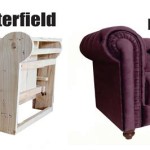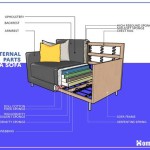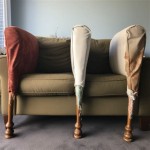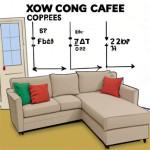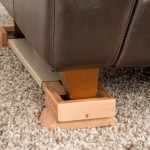Average Corner Sofa Dimensions
Corner sofas, also known as sectional sofas, provide ample seating and a visually appealing arrangement for living rooms and family rooms. Understanding typical corner sofa dimensions is crucial for planning furniture placement and ensuring a comfortable and functional living space. This article explores the standard measurements of corner sofas, considering variations in configuration and style.
The "L" shape, the most common configuration for corner sofas, consists of two perpendicular sections joined at a right angle. Measurements for these sofas are typically expressed as the length of each section. The shorter section, often referred to as the "chaise" or "return," generally ranges from 78 inches to 96 inches. The longer section commonly measures between 96 inches and 114 inches. It's important to note that these are average dimensions, and considerable variations exist depending on the manufacturer and specific model.
Beyond the standard "L" shape, corner sofas can be configured in various other arrangements. U-shaped sofas, for example, feature three sections creating a "U" configuration. Measuring U-shaped sofas involves determining the length of each section. Typical dimensions for the two parallel sections range from 78 inches to 114 inches, while the connecting section generally measures between 48 inches and 72 inches. These measurements can vary significantly depending on the overall size and design of the sofa.
Another popular configuration is the modular sofa, which offers greater flexibility in arrangement. Modular sofas consist of individual sections that can be combined in various ways to create different shapes and sizes. The dimensions of each module will vary depending on its intended function, such as a corner piece, armless chair, or chaise lounge. Determining the overall dimensions requires considering the number and arrangement of modules selected.
Beyond the overall length and configuration, several other dimensional factors are essential to consider when selecting a corner sofa. Seat depth, the distance from the front edge of the seat cushion to the back, typically ranges between 22 inches and 28 inches. A comfortable seat depth allows for adequate legroom while providing sufficient back support.
Seat height, the distance from the floor to the top of the seat cushion, is another crucial dimension. Standard seat height ranges from 17 inches to 19 inches. This dimension influences how easy it is to sit down and stand up from the sofa and should be considered in relation to the height of other furniture in the room.
Overall height, measured from the floor to the highest point of the sofa back, can vary significantly depending on the style and design. Low-profile sofas may have an overall height of around 30 inches, while sofas with high backs can measure up to 40 inches or more. Considering the overall height is essential for ensuring the sofa fits comfortably within the room's vertical space.
Armrest height and width also contribute to the overall dimensions and comfort of a corner sofa. Armrest height typically ranges from 20 inches to 26 inches, influencing how comfortable it is to rest one's arms. Armrest width can vary from a few inches to over a foot, impacting the overall footprint of the sofa.
When selecting a corner sofa, it's crucial to measure the available space in the room carefully. Accurate measurements will ensure the sofa fits comfortably without obstructing walkways or other furniture. Consider not just the length and width of the sofa, but also the diagonal depth, particularly for L-shaped sofas, to ensure it will fit through doorways and hallways.
Beyond the physical dimensions, the style and design of the corner sofa can also impact its perceived size. Sofas with bulky arms and thick cushions will appear larger than those with slimmer profiles. The color and fabric choice can also influence the perceived size, with darker colors tending to make the sofa appear smaller and lighter colors making it appear larger.
Finally, consider additional features like reclining seats, built-in storage, or pull-out beds, as these can affect the overall dimensions and functionality of the corner sofa. Reclining mechanisms can add several inches to the depth when fully extended, while built-in storage can impact the available seating space.
Selecting the right corner sofa involves careful consideration of various dimensional factors, including length, depth, height, and configuration. Taking accurate measurements of the available space and understanding the standard dimensions of different sofa styles are essential steps in ensuring a comfortable and functional living room arrangement.

Sofa Size Guide How To Measure For A Timeless Chesterfields Blog

Nimbus Ii Large Corner Sofa Heal S

Cosy Velvet Mustard Solid Wood Corner Sofa 260 Cm Artico Interiors

L Shape Sofa Set Extra Large Corner Fabric Gray Gkw Retail

Grey Dylan Jumbo Cord Left And Right Hand Corner L Shape Sofa Kg Furniture

Left Hand Fabric Corner Sofa With Ottoman Light Grey Oslo Furniture Lamps Accessories Up To 70 Off Avandeo

John Lewis Barbican 5 Seater Corner Sofa

Oslo Fabric Modern Corner 6 Seater Sofa Set With Ottoman Grey Or Beige Sofas

Magic Home 85 In L Shape Corner Sofa Couch Velvet Fabric Sectional With Storage Ottoman And Cup For Dorm Apartment Grey Cs Lp000049aae The Depot

Francine Corner Sofa Furniture Manila

